形容词修饰不定代词的用法
形容词作后置定语的几种常见情况
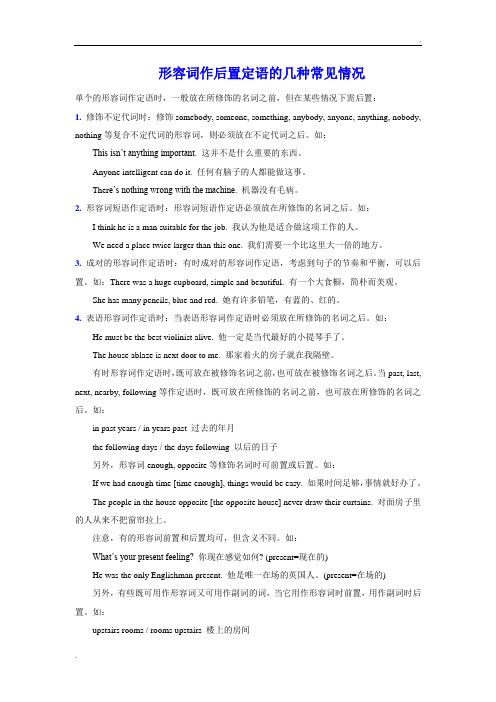
形容词作后置定语的几种常见情况单个的形容词作定语时,一般放在所修饰的名词之前,但在某些情况下需后置:1. 修饰不定代词时:修饰somebody, someone, something, anybody, anyone, anything, nobody, nothing等复合不定代词的形容词,则必须放在不定代词之后。
如:This isn’t anything important. 这并不是什么重要的东西。
Anyone intelligent can do it. 任何有脑子的人都能做这事。
Ther e’s nothing wrong with the machine. 机器没有毛病。
2. 形容词短语作定语时:形容词短语作定语必须放在所修饰的名词之后。
如:I think he is a man suitable for the job. 我认为他是适合做这项工作的人。
We need a place twice larger than this one. 我们需要一个比这里大一倍的地方。
3. 成对的形容词作定语时:有时成对的形容词作定语,考虑到句子的节奏和平衡,可以后置。
如:There was a huge cupboard, simple and beautiful. 有一个大食橱,简朴而美观。
She has many pencils, blue and red. 她有许多铅笔,有蓝的、红的。
4. 表语形容词作定语时:当表语形容词作定语时必须放在所修饰的名词之后。
如:He must be the best violinist alive. 他一定是当代最好的小提琴手了。
The house ablaze is next door to me. 那家着火的房子就在我隔壁。
有时形容词作定语时,既可放在被修饰名词之前,也可放在被修饰名词之后。
当past, last, next, nearby, following等作定语时,既可放在所修饰的名词之前,也可放在所修饰的名词之后。
高中英语语法—形容词、副词

例题
1) Tony is going camping with ___ boys. A. little two other B. two little other C. two other little D. little other two
答案点拨:C 由"限定词--数词--描绘词--(大小,长短,形状,新 旧,颜色) --性质--名词"的公式可知数词,描绘词,性质依次顺序 只有C符合答案。
2、+ed
excite—excited worry—worried surprise—surprised close—closed interest—interested frighten—frightened
3、+ing
interest—interesting excite—exciting surprise—surprising follow—following
4、+y 所有表示天气状况的的形容词
sun—sunny snow—snowy wind—windy rain-rainy cloud—cloudy health—healthy
5、+ en
wool-woolen wood--wooden
6、+ern (东西南北)
east--eastern south-southern west--western north--northern
多个形容词做定语时的排列顺序:
在不确定的时候,可参照如下口诀: 美小圆旧黄,法国木书房 注释:美——描述性质;小——大小、长短、 高矮胖瘦 旧——新旧、年龄 圆——形状;黄——颜色;法国——产地、 国籍;木——材料;书房——用途 a new red silk cap一顶红色新丝帽 a short young Japanese businessman
形容词修复合不定代词

形容词修复合不定代词1. 不定代词碰上形容词,那可就像魔法棒点了普通物件,立马变得超有趣。
比如说“我今天遇到了某件特别的事,这件事啊,就像黑夜里突然亮起的一颗超亮的星,把我的一天都变得不一样了。
”这“特别的”就是形容词修饰不定代词“某件”,就这么一搭配,平平无奇的事儿都变得神秘又吸引人了。
2. 形容词和不定代词搭一块儿,那感觉就像厨师给菜加了独特的调料。
像“有人给我讲了个好笑的东西,这个东西啊,像一阵春风吹进了我有点沉闷的生活里。
”这里“好笑的”形容“东西”这个不定代词,能让人一下子就好奇,到底是什么东西这么好笑呢?3. 不定代词要是有形容词来修饰,就像给一张白纸画上了绚丽的色彩。
我记得“他跟我说过某个奇妙的地方,那个地方就像童话里的神秘王国一样。
”“奇妙的”让“某个地方”变得充满想象,让人忍不住想多问几句那个地方的情况。
4. 形容词和不定代词组合起来,就如同给一个小木偶注入了灵魂。
好比“我在找一些有用的信息,这些信息就像宝藏一样珍贵。
”“有用的”修饰“一些信息”,这么一说,谁不想赶紧知道是什么信息这么有用呢?5. 当形容词与不定代词相遇,就像给一个小音符配上了独特的旋律。
像“她给我看了某张漂亮的画,那张画就像一扇通往美好世界的窗户。
”“漂亮的”让“某张画”变得魅力十足,别人肯定就想看看这画到底长啥样。
6. 不定代词有了形容词相伴,就像是给孤独的行者找到了温暖的伙伴。
我曾有过“发现某个有趣的玩意儿,这个玩意儿就像打开快乐大门的钥匙。
”“有趣的”修饰“某个玩意儿”,这一下子就吊起了别人的胃口。
7. 形容词和不定代词凑一块,就像给干枯的树枝添上了鲜嫩的绿叶。
比如“我们都在等某些重要的消息,这些消息就像黑暗中的曙光。
”“重要的”形容“某些消息”,让大家都急切地想知道是什么消息这么重要。
8. 不定代词和形容词搭起来,仿佛给一片空白的画布抹上了惊艳的色彩。
我听说“有人得到了某个惊人的消息,那个消息就像一颗炸弹在平静的湖水里炸开。
形容词修饰不定代词的用法

形容词修饰不定代词的用法
1. 哇塞,不定代词 something 可有不少奇妙的用法呢!比如“ There is something interesting in this book. ”(这本书里有一些有趣的东西),你看,这里用“interesting”这个形容词来修饰“something”,多贴切呀!
2. 嘿,不定代词 anything 也很特别哦!“Is there anything wrong? ”(有什么不对劲的吗),“wrong”很好地修饰了“anything”,是不是
很奇妙?
3. 呀,不定代词 nothing 也能这样用呢!“He has nothing important to say. ”(他没什么重要的事要说。
),这里“important”修饰“nothing”,是不是很有意思呀!
4. 哎呀,不定代词 somebody 也能这么搭配哟!“There is somebody nice waiting for you. ”(有个很好的人在等你。
),“nice”让“somebody”更加生动形象啦!
5. 哟呵,不定代词 anybody 也不例外呢!“Anybody intelligent can do it. ”(任何有才智的人都能做这件事。
),“intelligent”对“anybody”的修饰太妙啦!
6. 哈哈,不定代词 nobody 也是一样呀!“Nobody famous came to the party. ”(没有什么出名的人来参加聚会。
),“famous”把“nobody”
描述得好准确呀!总之,形容词修饰不定代词的用法真的超有趣,让我们能更准确地表达意思,大家可要好好掌握呀!。
高中语法 专题13形容词和副词

选修八
英语
高考总复习人教版
二、副词 1.多个副词同时出现时的顺序
(1)方式副词→地点副词→时间副词
(2)小的时间/地点→大的时间/地点 2.以下以-ly结尾的词均为形容词,如:lovely, lively,likely,friendly等。
选修八
英语
高考总复习人教版
3.以下用法中的very均是错误的 (1)I very like English.改为:I like English very much.
hottest biggest
easy early
easier earlier
easiest earliest
词尾是辅音加y,先把y改为 i,再加-er或-est
选修八
英语
高考总复习人教版
(2)多数多音节形容词,前面加more或most
原级 useful important 比较级 more useful more important 最高级 most useful most important
选修八
英语
高考总复习人教版
三、形容词和副词的级 1.比较等级的构成
(1)单音节和少数双单节形容词
原级 great clever brave simple hot big 比较级 greater cleverer braver simpler hotter bigger 最高级 greatest cleverest bravest simplest 构成方法 一般的单音节及少数双音节 词,在词尾加上-er或-est 词尾是不发音的e时,只加-r 或-st 重读闭音节词尾是一个辅音 字母,需重复辅音字母,再 加-er或-est
靠近,nearly几乎;short短,shortly不久;close靠近,
英语中形容词的用法

2) 表示三者或三者以上(人或事物)的 比较用最高级,最高级的前面一般要加
定冠词the,后面可带of(in,among)
短语来说明比较的范围
*Shanghai is the biggest city in China.
*Lucy sings (the) best of all.
*He is the most careful among us.
5)几种比较级的使用句型 1.“ 比较级 + and + 比较级 ” 表示“ 越来越······”
*Your English is getting better and better. 你的英语越来越好了。 *These days more and more people are learning English. 现在学英语的人越来越多了。
3) 在表示 “和······一样······” 和 “不及······” 这类概念时,可以用 “as+原级+as” 和 “not as(so) +原级+as”的句型
*Our teacher is as busy as before.
*He does not run so (as) fast as 用来修饰名词或代词, 表示人或 事物的性质, 状态,和特征。
二、形容词的用法:
1. 作定语,一般放在名词之前, 不定 代词 something,anything,nothing, everything 等之后。
eg. It’s a sunny day today.
今天是个阳光灿烂的日子。
电影里有什么有趣的内容吗?
There is nothing dangerous here. 这儿一点都不危险。
形容词副词的用法
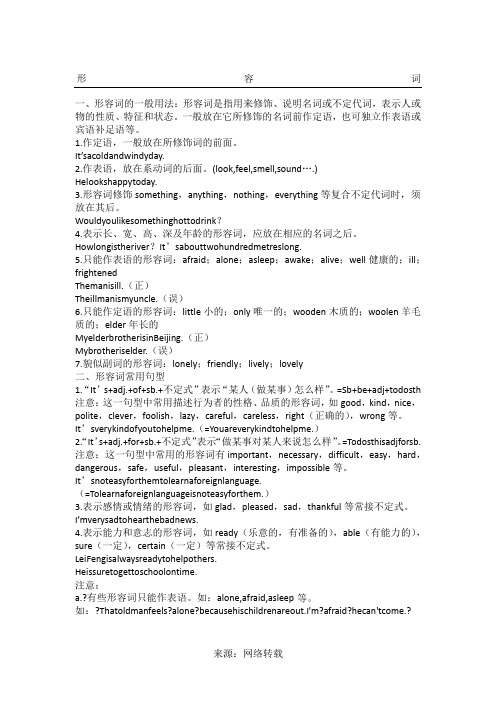
形容词一、形容词的一般用法:形容词是指用来修饰、说明名词或不定代词,表示人或物的性质、特征和状态。
一般放在它所修饰的名词前作定语,也可独立作表语或宾语补足语等。
1.作定语,一般放在所修饰词的前面。
It’sacoldandwindyday.2.作表语,放在系动词的后面。
(look,feel,smell,sound….) Helookshappytoday.I’mverysadtohearthebadnews.4.表示能力和意志的形容词,如ready(乐意的,有准备的),able(有能力的),sure(一定),certain(一定)等常接不定式。
LeiFengisalwaysreadytohelpothers.Heissuretogettoschoolontime.a.?有些形容词只能作表语。
如:alone,afraid,asleep如:?Thatoldmanfeels?alone?becausehischildrenareout.I'm?afraid?hecan'tcome.?b.?形容词与不定代词something,anything,nothing,everything等连用时,要放在这些词后面。
如:?Thereis?something?wrongwithmyDVDmachine.It's?nothing?serious.?c.?某些形容词可以和定冠词连用,表示一类人或事物,其作用相当于一个名词。
如:?theyoung(年轻人),thepoor(穷人),therich(富人)?d.?如果有两个以上的形容词修饰同一个名词时,其前后排列顺序一般如下:限定词(a/the,this/some/her……)+数量词(先序数词后基数词)+观点+大小+形状+新旧+颜色+产地+材料+名词。
如:abigoldGermancomputerⅡ副词DaiYuqiangsings?quite?well.?.副词表示频度修饰动词时,位于连系动词和助动词之后,行为动词之前。
形容词修饰不定代词的用法

形容词修饰不定式代词的用法【1】something interesting意为“一些有趣的东西”,形容词修饰不定代词或不定副词时,须位于不定代词或不定副词之后,作后置定语。
Last night,I saw someone strange lying on the ground near my home.昨晚在我家附近,我看见一个陌生人躺在地上。
Many people like to go somewhere interesting to have a vacation.许多人喜欢去有趣的地方度假。
1,My host family tried to cook_______for me when I studied In New Zeanland.A ,different something B,different anythingC,something different D,anything different2,You have just read the newspaper. Did you find_____in it?A ,interesting anything B,anything interesting C,interesting something3,Old Henry is so lonely that he hopes to know about________every day.A ,special something B,special anything C,something special D,anything special4,There is_______with my computer. Can you help me mend it?A ,nothing wrong B,anything wrong C,something wrong D,wrong something5,格林夫妇计划去某个轻松的地方度假。
形容词与副词
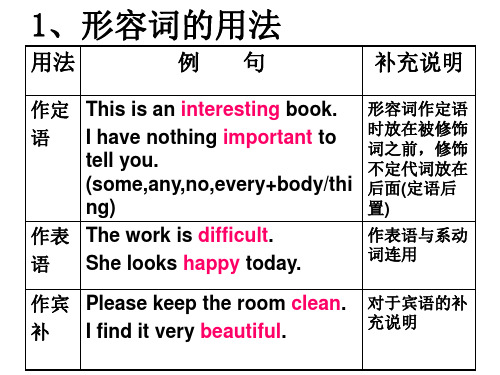
est(最高级)以字母e接尾B的i词gg加err或Bhiogtgtlaeersrget whiodettest
st
fatter wfaetttteesrt Wettest
以重读闭音节结尾的词末尾只有H一appieBHrigadhproipteirest
个或e辅s音t 字母应双写辅音字母再加eNaearrrlireorwthdienrNrifeaatsrwtreoetwarelisetst
作状语 He runs fast
作宾补 I found him outside
2.有许多副词是对应的形容词
加ly构成,
如: strong
strongly
real
really
词尾是y的要把y变为i再加 ly,
如:busy
busily
happy
happily
以e结尾的,大部分直接加-ly,
如:wide
and I didn't go, too. [正] He didn't go to the cinema yesterday and
I didn't go either. [误] I will come here to help you each three days. [正] I will come here to help you every three days. [析] every three days 为“每三天”,即每隔二天, 而every other day为每隔一天。
定语修饰不定代词放在后面的例子

定语修饰不定代词放在后面的例子不定代词做定语都要后置。
形容词作定语修饰不定代词something,anything,nothing等时,必须放在不定代词之后。
例如:
Let's give her something different to eat,then.那我们就给她一些别的东西吃吧。
I have something important to tell you.我有一些重要的事情要告诉你。
Can you see anything unusual in the picture?你能在这幅画中看出不寻常的东西吗?
Nothing difficult!没有什么难的!
不定代词后定语从句:
1、先行词为
all,much,everything,nothing,something,anything,nothing,等不定代词时;
2、先行词被only,any,few,little,no,all,just,very,right 等修饰时。
3、当先行词是最高级或被形容词最高级修饰时。
4、当先行词是序数词或被序数词修饰时。
5、当先行词是数词时。
6、当先行词既指人又指物时。
7、如有两个定语从句,其中一个关系代词已用which,另一个关系代词则宜用that。
8、主句是There be结构,修饰其主语的定语从句宜用that作关系代词。
9、被修饰成分为表语,或者关系代词本身是定语从句的表语时,该关系代词宜用that。
10、先行词为what,关系代词用that。
11、有时为了避免重复而使用that引导定语从句。
人教目标九年级英语全一册Unit 1 形容词修饰不定代词不定副词的用法

创新微课
形容词修饰不定代词/不定副词的用法
Is there anywhere else for us to live?
What shall we do ?
创新微课
形容词修饰不定代词/不定副词的用法
What a beautiful place! How cozy(舒服的)!
创新微课
•
9、要学生做的事,教职员躬亲共做; 要学生 学的知 识,教 职员躬 亲共学 ;要学 生守的 规则, 教职员 躬亲共 守。20 21/7/2 12021/ 7/21We dnesda y, July 21, 2021
C something wrong D wrong something
形容词修饰不定代词/不定副词的用法
回顾总结
1 不定代词
不定副词
肯定句 否定句/ 疑问句
创新微课
同学,下节再见
• 15、一年之计,莫如树谷;十年之计,莫如树木;终身之计,莫如树人。2021年7月2021/7/212021/7/212021/7/217/21/2021
• 16、提出一个问题往往比解决一个更重要。因为解决问题也许仅是一个数学上或实验上的技能而已,而提出新的问题,却需要有创造性的想像力,而且标志着科学的真正进步。2021/7/212021/7/21July 21, 2021
创新微课
形容词修饰不定代词/不定副词的用法
格林夫妇计划去某个轻松的地方度假。 The Greens are planning to go _s_o_m__e_w_h_e_r_e_ _re_l_a_x_in_g______ for vo1cations.
创新微课
形容词修饰不定代词/不定副词的用法
创新微课
形容词的基本概念及用法
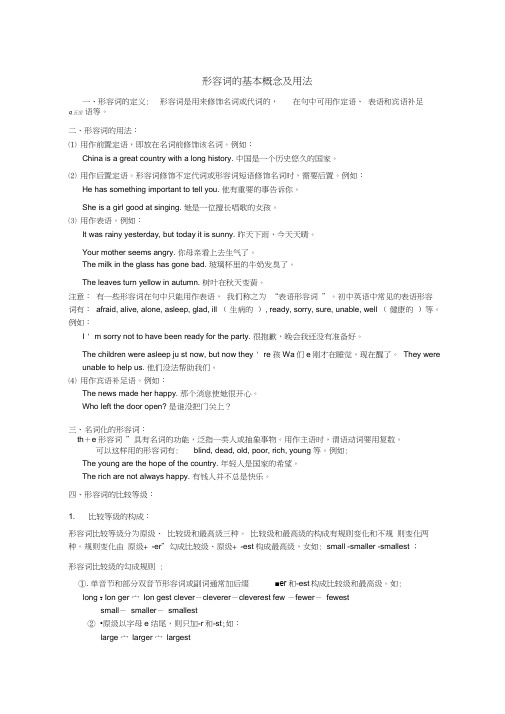
形容词的基本概念及用法一、形容词的定义:形容词是用来修饰名词或代词的,在句中可用作定语、表语和宾语补足q五坐语等。
二、形容词的用法:⑴ 用作前置定语,即放在名词前修饰该名词。
例如:China is a great country with a long history. 中国是一个历史悠久的国家。
⑵ 用作后置定语。
形容词修饰不定代词或形容词短语修饰名词时,需要后置。
例如:He has something important to tell you. 他有重要的事告诉你。
She is a girl good at singing. 她是一位擅长唱歌的女孩。
⑶ 用作表语。
例如:It was rainy yesterday, but today it is sunny. 昨天下雨,今天天晴。
Your mother seems angry. 你母亲看上去生气了。
The milk in the glass has gone bad. 玻璃杯里的牛奶发臭了。
The leaves turn yellow in autumn. 树叶在秋天变黄。
注意:有一些形容词在句中只能用作表语,我们称之为“表语形容词”。
初中英语中常见的表语形容词有:afraid, alive, alone, asleep, glad, ill (生病的), ready, sorry, sure, unable, well (健康的)等。
例如:I ' m sorry not to have been ready for the party. 很抱歉,晚会我还没有准备好。
The children were asleep ju st now, but now they ' re 孩Wa们e刚才在睡觉,现在醒了。
They were unable to help us. 他们没法帮助我们。
⑷ 用作宾语补足语。
例如:The news made her happy. 那个消息使她很开心。
adj和adv的用法

adj和adv的用法在英语中,形容词(adj)和副词(adv)都是描述词类,它们都有着非常重要的作用。
形容词用于描述或限定名词,而副词则用于描述或限定形容词、动词、或其他副词。
下面我们将分步骤来介绍这两种词类的用法。
一、形容词的基本用法1. 形容词用于限定或描述名词或代词,它通常位于名词或代词前面。
例如:a beautiful flower(一朵美丽的花),a tall man (一个高个子的男人)。
2. 形容词可以用来修饰不定代词,例如:something interesting(有趣的事情),anything good(好的东西),someone special(特别的人)。
3. 形容词可以用于比较级和最高级,例如:bigger(更大的),biggest(最大的)。
4. 形容词也可以作为表语,例如:The cake is delicious(这个蛋糕很好吃),She is pretty(她很漂亮)。
二、副词的基本用法1. 副词用于修饰动词、词组、形容词或其他副词,并通常位于它所修饰的词的后面。
例如:She speaks English fluently(她说英语很流利)。
2. 副词可以被用来表示时间、地点、频率、方式等等。
例如:He runs fast(他跑得很快)。
3. 副词可以用于比较级和最高级,例如:faster(更快的),fastest(最快的)。
4. 副词可以作为句子的修饰语。
例如:Unfortunately, I missed the train(不幸的是,我错过了火车)。
总之,形容词和副词都是非常重要的英语语法要素。
我们要学会正确使用它们,让我们的英语表达更加准确、地道。
2010年中考英语语法复习—形容词、副词

最高级 tallest nicest
thinnest wettest
busier happier more importan t
busiest happiest the most importa nt
不规则变化
原 good 级 well bad many little badly much ill 比 better worse more less 较 级 最 best worst most least 高 级 old far
2. Would you like to tell me _____ about your friends?
A. something different B. different anything C. different something D. anything different
3. I have ______ to do today. A. anything important B. something important C. important nothing D. important something
1.Tony is ___ boy. A. a quite smart C. quite a smart
B. very a smart
2.It is raining ___. A.heavy B.heavily
C.big
3.Bill is running __ to catch up the others A. enough quickly B.quick enough C. quickly enough 4.I have never been there, ___. A. too B. either C. also
不定代词的宾格与形容词性用法的辨析解读
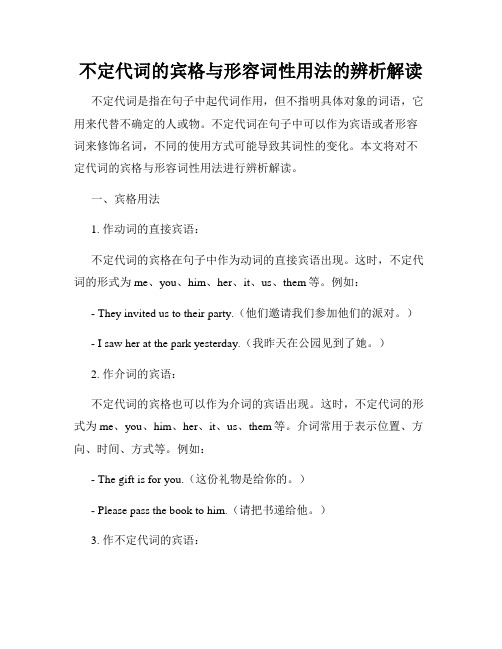
不定代词的宾格与形容词性用法的辨析解读不定代词是指在句子中起代词作用,但不指明具体对象的词语,它用来代替不确定的人或物。
不定代词在句子中可以作为宾语或者形容词来修饰名词,不同的使用方式可能导致其词性的变化。
本文将对不定代词的宾格与形容词性用法进行辨析解读。
一、宾格用法1. 作动词的直接宾语:不定代词的宾格在句子中作为动词的直接宾语出现。
这时,不定代词的形式为me、you、him、her、it、us、them等。
例如:- They invited us to their party.(他们邀请我们参加他们的派对。
)- I saw her at the park yesterday.(我昨天在公园见到了她。
)2. 作介词的宾语:不定代词的宾格也可以作为介词的宾语出现。
这时,不定代词的形式为me、you、him、her、it、us、them等。
介词常用于表示位置、方向、时间、方式等。
例如:- The gift is for you.(这份礼物是给你的。
)- Please pass the book to him.(请把书递给他。
)3. 作不定代词的宾语:有些动词或短语后面可以跟不定代词的宾格形式作为宾语,表示无特指的人或物。
常见的这类动词或短语有teach、tell、show、ask等。
例如:- Can you teach me how to swim?(你能教我游泳吗?)- He told her the secret.(他告诉了她这个秘密。
)二、形容词性用法1. 作表语:不定代词的形容词性用法在句子中作为表语出现,用来修饰主语,并与主语进行一定的搭配。
不定代词的形式为myself、yourself、himself、herself、itself、ourselves、themselves等。
例如:- I myself did all the work.(我自己完成了所有的工作。
)- They themselves decided to go on a trip.(他们自己决定去旅行。
不定代词的用法
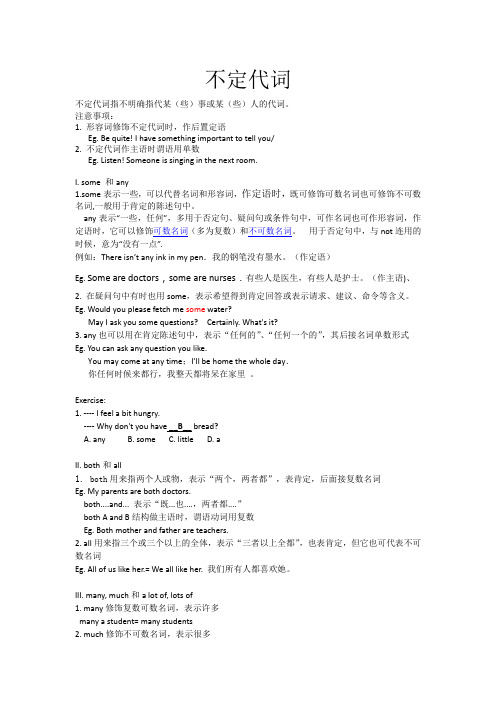
不定代词不定代词指不明确指代某(些)事或某(些)人的代词。
注意事项:1. 形容词修饰不定代词时,作后置定语Eg. Be quite! I have something important to tell you/2. 不定代词作主语时谓语用单数Eg. Listen! Someone is singing in the next room.I. some 和any1.some表示一些,可以代替名词和形容词,作定语时,既可修饰可数名词也可修饰不可数名词,一般用于肯定的陈述句中。
any表示“一些,任何”,多用于否定句、疑问句或条件句中,可作名词也可作形容词,作定语时,它可以修饰可数名词(多为复数)和不可数名词。
用于否定句中,与not连用的时候,意为“没有一点”.例如:T here isn’t any ink in my pen.我的钢笔没有墨水。
(作定语)Eg. Some are doctors,some are nurses.有些人是医生,有些人是护士。
(作主语)、2. 在疑问句中有时也用some,表示希望得到肯定回答或表示请求、建议、命令等含义。
Eg. Would you please fetch me some water?May I ask you some questions? Certainly. What's it?3. any也可以用在肯定陈述句中,表示“任何的”、“任何一个的”,其后接名词单数形式Eg. You can ask any question you like.You may come at any time;I’ll be home the whole day.你任何时候来都行,我整天都将呆在家里。
Exercise:1. ---- I feel a bit hungry.---- Why don't you have __B__ bread?A. anyB. someC. littleD. aII. both和all1. both用来指两个人或物,表示“两个,两者都”,表肯定,后面接复数名词Eg. My parents are both doctors.both....and... 表示“既...也....,两者都....”both A and B结构做主语时,谓语动词用复数Eg. Both mother and father are teachers.2. all用来指三个或三个以上的全体,表示“三者以上全都”,也表肯定,但它也可代表不可数名词Eg. All of us like her.= We all like her. 我们所有人都喜欢她。
关于形容词的用法
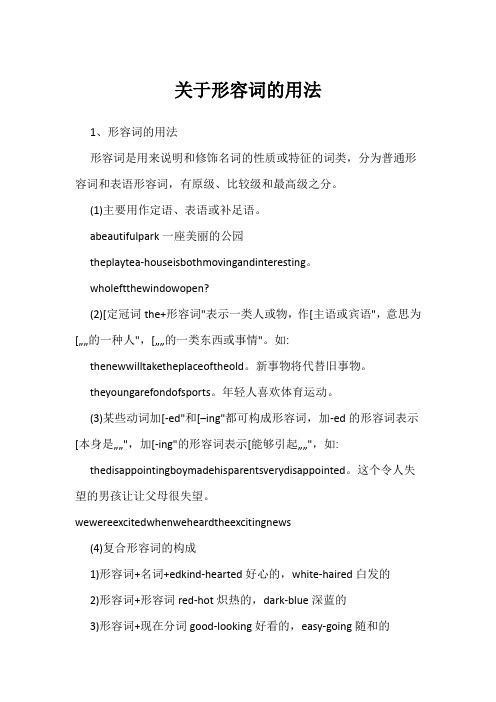
关于形容词的用法1、形容词的用法形容词是用来说明和修饰名词的性质或特征的词类,分为普通形容词和表语形容词,有原级、比较级和最高级之分。
(1)主要用作定语、表语或补足语。
abeautifulpark一座美丽的公园theplaytea-houseisbothmovingandinteresting。
wholeftthewindowopen?(2)[定冠词the+形容词"表示一类人或物,作[主语或宾语",意思为[……的一种人",[……的一类东西或事情"。
如:thenewwilltaketheplaceoftheold。
新事物将代替旧事物。
theyoungarefondofsports。
年轻人喜欢体育运动。
(3)某些动词加[-ed"和[–ing"都可构成形容词,加-ed的形容词表示[本身是……",加[-ing"的形容词表示[能够引起……",如:thedisappointingboymadehisparentsverydisappointed。
这个令人失望的男孩让让父母很失望。
wewereexcitedwhenweheardtheexcitingnews(4)复合形容词的构成1)形容词+名词+edkind-hearted好心的,white-haired白发的2)形容词+形容词red-hot炽热的,dark-blue深蓝的3)形容词+现在分词good-looking好看的,easy-going随和的4)副词+现在分词hard-working勤劳的,fast-moving快速转动的5)副词+过去分词hard-won得来不易的,newly-made新建的6)名词+形容词life-long终生的,world-famous世界闻名的7)名词+现在分词peace-loving爱好和平的,fun-loving爱开玩笑的8)名词+过去分词snow-covered白雪覆盖的,hand-made手工的9)数词+名词+edfour-storeyed4层楼的,three-legged3条腿的10)数词+名词(名词用单数)ten-year10年的,two-man两人的2、副词的用法副词在句子中主要用作状语,用来修饰动词、形容词和其他副词的词,有时还可修饰介词短语和句子。
不定代词的用法
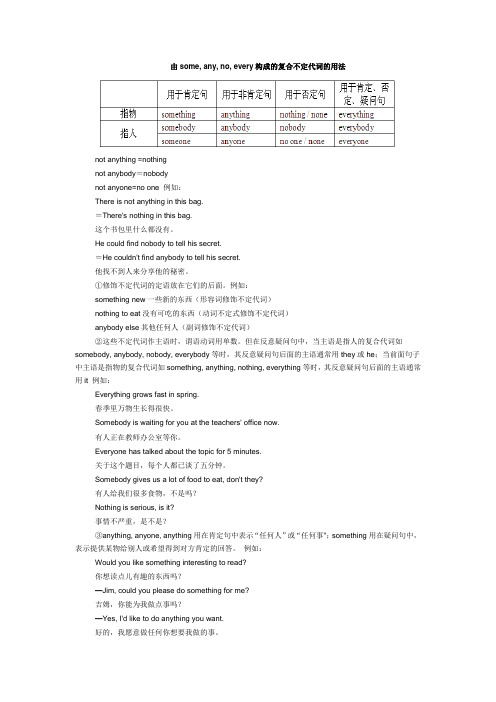
由some, any, no, every构成的复合不定代词的用法not anything =nothingnot anybody=nobodynot anyone=no one 例如:There is not anything in this bag.=There's nothing in this bag.这个书包里什么都没有。
He could find nobody to tell his secret.=He couldn't find anybody to tell his secret.他找不到人来分享他的秘密。
①修饰不定代词的定语放在它们的后面。
例如:something new一些新的东西(形容词修饰不定代词)nothing to eat没有可吃的东西(动词不定式修饰不定代词)anybody else其他任何人(副词修饰不定代词)②这些不定代词作主语时,谓语动词用单数。
但在反意疑问句中,当主语是指人的复合代词如somebody, anybody, nobody, everybody等时,其反意疑问句后面的主语通常用they或he;当前面句子中主语是指物的复合代词如something, anything, nothing, everything等时,其反意疑问句后面的主语通常用it 例如:Everything grows fast in spring.春季里万物生长得很快。
Somebody is waiting for you at the teachers' office now.有人正在教师办公室等你。
Everyone has talked about the topic for 5 minutes.关于这个题目,每个人都已谈了五分钟。
Somebody gives us a lot of food to eat, don't they?有人给我们很多食物,不是吗?Nothing is serious, is it?事情不严重,是不是?③anything, anyone, anything用在肯定句中表示“任何人”或“任何事";something用在疑问句中,表示提供某物给别人或希望得到对方肯定的回答。
- 1、下载文档前请自行甄别文档内容的完整性,平台不提供额外的编辑、内容补充、找答案等附加服务。
- 2、"仅部分预览"的文档,不可在线预览部分如存在完整性等问题,可反馈申请退款(可完整预览的文档不适用该条件!)。
- 3、如文档侵犯您的权益,请联系客服反馈,我们会尽快为您处理(人工客服工作时间:9:00-18:30)。
形容词修饰不定代词的
用法
LG GROUP system office room 【LGA16H-LGYY-LGUA8Q8-LGA162】
形容词修饰不定式代词的用法
something interesting意为“一些有趣的东西”,形容词修饰不定代词或不定副词时,须位于不定代词或不定副词之后,作后置定语。
Last night,I saw someone strange lying on the ground near my home.
昨晚在我家附近,我看见一个陌生人躺在地上。
Many people like to go somewhere interesting to have a vacation.
许多人喜欢去有趣的地方度假。
1,My host family tried to cook_______for me when I studied In New Zeanland.
A ,different something B,different anything
C,something different D,anything different
2,You have just read the newspaper. Did you find_____in it?
A ,interesting anything B,anything interesting C,interesting something
3,Old Henry is so lonely that he hopes to know about________every day.
A ,special something B,special anything C,something special D,anything special
4,There is_______with my computer. Can you help me mend it?
A ,nothing wrong B,anything wrong C,something wrong D,wrong something
5,格林夫妇计划去某个轻松的地方度假。
The Greens are planning to go_______ _____for vocations.
答案
1,C,2,B,3,C,4,C,5,somewhere relaxing。
